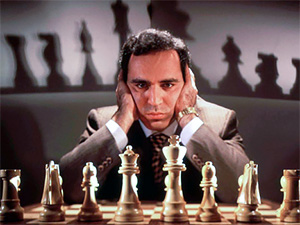For hundreds of years, Chess has been the standard that man used to judge himself and machines. The greatest (and first) math professor in Europe, over five hundred years ago, wrote a book with his best student Leonardo DaVinci about it and the father of computer science used chess to illustrate an early version of machine learning (although the computers at the time could not run the program). Even my hero Claude Shannon weighed in on the subject. It is because of this rich history that IBM decided to tackle the problem to demonstrate the power of its computers.
Garry Kasparov versus Deep Blue
Deep Blue was a very public version of a domain-specific integrated hardware and software architecture. The project involved many of its best and a good number of “content specialists” (chess masters). Then it set its sights not on beating any particular individual but on beating all men. So by extension, if you beat up the toughest guy in town, then you are the new toughest guy in town. The current “toughest guy in town” at the time was non other than Garry Kasparov, the world chess champion. He’s the happy guy below. This picture kind of reminds me of Kroonsteen, one of the greatest James Bond villains of all time, also a Chess Master.

The battle was legendary, and not without controversy, with Kasparov claiming that Deep Blue had cheated. Regardless of this claim, Kasparov eventually conceded defeat not because he said he lost, but because he said he would have lost within a year or two because Deep Blue kept on getting faster and effectively better at the game.
Kasparov’s Lesson: Work with the Machines
Not one to take defeat lightly, Kasparov sought to learn more about how a man could learn to work with a machine, or better stated how a man could use machines to defeat machines. So the intellectual’s version of John Connor began the chess equivalent of open fights, or in other words “anything goes fights.” A person could walk into the fight with a machine, a group of machines, or anything. Setting up these “Hybrid Tournaments,” Kasparov waited and watched. Bets were placed. Would a younger version of Kasparov emerge that could be mankind’s answer to the machine menace? Or would a group of humans be able to gang up and beat the machine? The answer was not either of these extremes, but something beautiful in between.
The victors in Kasparov’s tournaments were not the best humans or the best machines alone, but groups of humans that had learned or evolved to work with groups of machines. Simply stated, groups of technologies and groups of humans put together in a properly optimized process beat superior humans or superior technology alone. Keep this in mind, if you took a chess champion or group of chess champions and gave them the best technology they would still not win…they had to be taught to work with the machines and likewise the machines had to evolve to give the humans what they needed. Machines doing what machines do well, humans doing what humans do well. In short, it is all about the process and how we work together! For those of you looking for a deeper review of these results, I highly suggest reading Kasparov’s book Deep Thinking.
Humans intelligence is Strategic, Machine intelligence is Tactical
Another way that Kasparov described the interaction man/machine is that human intelligence is strategic and machine intelligence is tactical. Humans figure out what to ask and how and machines can give the answer. It all comes down to defining problems and being creative in that process for humans and to getting the problems in a format (or model) that the machine can address. As Sun Tzu said over two thousand years ago, “Strategy without tactics is the slowest route to victory. Tactics without strategy is the noise before defeat. ” Everyone knows that finance is all about speed, so AI is inevitable in finance, it just needs to be married with strategy.
I personally find this not only to be informative but also inspiring. We are not going into an age when AI or Machine Learning will destroy employment opportunities, but it will instead create new opportunities. Machines will handle the tactical tasks of computing, while human beings will handle the strategic tasks of figuring out what to calculate. While Kasparov and a few other thinkers like Brynjolfsson and McAfee have spoken about relationship bringing us to a “Second Machine Age,” I personally think that the best map forward can be found in some of the work of one of my heroes, a man named Homer (and I don’t mean Marge’s husband).
And for those of you who haven’t guessed, Homer was one of my inspirations for giving the ULISSES Project its name, but more on that next week.

